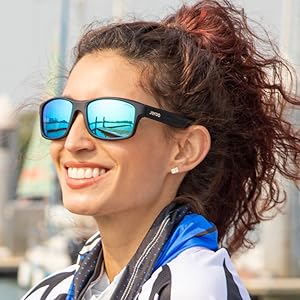As the sun goes down, roads get darker and driving becomes more challenging. Statistics show that the risk of accidents at night is significantly higher than during the day—largely due to reduced visibility and glare from headlights.
To stay safe after dark, you need more than cautious driving and adherence to traffic rules—proper eyewear can make a huge difference. Night driving glasses help reduce glare, sharpen contrast, and protect your eyes, giving you a clearer and safer view of the road.
This guide breaks down the challenges of night driving, how night driving glasses work, and what to look for when choosing a pair.
I. Challenges of Nighttime Driving
(I) Insufficient Light
Natural light decreases significantly at night, making the road environment much darker than during the day. This significantly limits a driver's field of vision and clarity. In such conditions, it's difficult to detect obstacles, pedestrians, and other vehicles, increasing the risk of accidents. Statistics show that insufficient light contributes significantly to nighttime traffic accidents. For example, on rural roads or remote stretches without streetlights, drivers often have difficulty seeing the road ahead, which can easily lead to collisions.
(2) Glare
Glare from oncoming headlights and bright road signs is a major problem when driving at night. It can cause momentary discomfort to the driver's eyes, even temporary blindness, seriously impairing their ability to judge road conditions. Studies have shown that glare can increase a driver's reaction time by several seconds when approaching other vehicles at night. At high speeds, these few seconds can lead to a serious accident.
(3) Fatigue and Sleepiness
At night, the body's circadian rhythm prompts the body to enter a resting state, making fatigue and drowsiness more likely to set in. In this state, the driver's reaction speed and decision-making ability decrease, making it difficult to respond to unexpected situations on the road. For example, long-distance drivers can easily lose focus due to fatigue when driving at night, increasing the likelihood of an accident.
2. The Functions of Night Driving Glasses
(1) Glare Reduction
The polarized lenses of night driving glasses can effectively filter out glare, softening the light and providing a clearer vision for the driver. For example, some lenses with special polarization technology can filter out stray light such as road reflections and headlight glare, reducing light interference to the eyes and thus reducing the risk of accidents.
(2) Contrast Enhancement
These glasses can enhance the contrast between objects and the background, making it easier for drivers to see road signs, obstacles, and other vehicles in low-light conditions. Through their specialized optical design, night driving glasses can highlight key information, helping drivers better judge road conditions.
(3) Eye Protection
In addition to addressing the unique lighting conditions of night, night driving glasses can also protect the eyes. For example, some glasses feature UV protection, preventing even small amounts of UV rays from damaging the eyes at night. Furthermore, glare reduction and appropriate light regulation can help alleviate eye fatigue and provide more comfortable eyesight during long drives.
III. How to Choose Night Driving Glasses
(I) Lens Material
Optical glass lenses: They offer high light transmittance, provide a clear field of vision, and are also highly abrasion-resistant. However, they are relatively heavy and expensive. For example, some high-end night driving glasses use high-quality optical glass lenses, offering drivers an excellent visual experience.
Resin lenses: They are lightweight, shatter-resistant, and relatively affordable. However, their abrasion resistance may be slightly inferior to that of optical glass lenses. Most night driving glasses on the market use resin lenses, which undergo special treatment to enhance their performance.
PC lenses: They offer excellent impact resistance, are lightweight, and possess excellent optical properties. They are often used in safety-critical driving glasses, effectively protecting the eyes from unexpected impacts.
(II) Lens Color
Yellow lenses: These are a common color for night driving glasses. Yellow lenses filter out some blue light, enhancing contrast and improving object clarity in low-light conditions, allowing drivers to see the road more clearly. For example, in rainy or foggy conditions, yellow lenses offer greater penetration, helping drivers see the road ahead more clearly.
Amber lenses: While reducing glare, amber lenses also offer excellent color reproduction, helping drivers better perceive the surrounding environment. They perform well in various nighttime driving scenarios and are a versatile lens color.
Gradient lenses: These lenses have a darker upper portion and a lighter lower portion. While driving, the upper portion effectively blocks glare from the front, while the lower portion allows drivers to easily view nearby information such as the instrument panel, meeting the needs of various driving scenarios.
(III) Polarization
Polarized lenses effectively reduce reflected light and glare, providing a clearer and more natural field of vision. During nighttime driving, polarized lenses filter out light reflected from the road surface, vehicle bodies, and other sources, allowing drivers to see road details more clearly. When choosing a lens, pay attention to the quality of the polarization. This can be determined by checking the product description or conducting a test. For example, hold the lenses up to a reflective object to see if they effectively eliminate the reflection and improve visual clarity.
(IV) Frame Design
Comfort: Choose frames that are lightweight and form-fitting to your face, ensuring comfortable wear for extended periods. For example, some frames are made of lightweight materials, such as carbon fiber and titanium alloy, which not only reduce weight but also provide flexibility to accommodate different face shapes. The design of the nose pads and temples is also important. Choose soft, adjustable nose pads and ergonomic temples to reduce pressure on the nose and ears.
Stability: The frames should be stable and prevent them from slipping due to head shaking or other movements while driving. Some frames feature special anti-slip features, such as silicone pads at the temple ends, to enhance wearing stability.
Field of View: Avoid choosing frames that are too large or too small. Oversized frames may partially obstruct your field of view, while undersized frames may not effectively block side light. The right frame size provides a wide field of view, allowing the driver to fully observe the road conditions while driving.
(V) Brand and QualityChoose night driving glasses from a reputable brand for greater assurance of quality and performance. Well-known brands typically invest significant resources in R&D and production, employing advanced technology and high-quality materials to ensure their products meet relevant standards. Furthermore, branded products are often market-proven and have a strong user reputation. When purchasing, check for product certifications, such as those that have passed relevant optical performance tests, to ensure quality.
IV. Recommended Night Driving Glasses
1. Sports Night Vision Aviator Glasses Yellow Horizon JF119: These are sporty night vision-enhancing aviator sunglasses. Their yellow lenses are ideal for use in low-light conditions, such as at night or in fog, improving visual clarity and reducing glare. The frames are lightweight, durable, and comfortable, and feature a classic aviator design that adapts to a variety of face shapes.
2. Aviator Night Vision Glasses For Driving Night Focus JF119: These are aviator-style night vision sunglasses designed specifically for driving. They focus on enhancing nighttime vision, effectively reducing glare from oncoming headlights and streetlights, enhancing vision clarity, and alleviating eye fatigue. The frames are designed to balance style and comfort, making them suitable for extended driving.
3. Photochromic Aviator Night Vision Glasses Midnight City JF119: These are photochromic aviator night vision sunglasses. "Midnight City" may have a more reserved, urban design. Photochromic lenses automatically adjust their color based on light intensity, reducing glare in bright daylight and maintaining clear vision at night or in low-light conditions. They also offer the stylish aesthetic of aviator sunglasse
4. Photochromic Night Vision Glasses for Women and Men Desert Camo JF119: These unisex photochromic night vision sunglasses feature a desert camouflage design. Photochromic technology allows them to adapt to varying light conditions, improving vision and reducing glare in low-light conditions. The desert camouflage design adds a unique sense of fashion and outdoor style, making them suitable for a variety of outdoor activities.
V. Tips for Safe Night Driving
1. Maintain Adequate Lighting
Regularly check your vehicle’s headlights, taillights, and signal lights to ensure they are clean and working properly. Bright, clear lights improve your visibility and make it easier for others to see you, reducing the risk of accidents.
2. Keep the Windshield Clean
A dirty windshield can scatter light and increase glare. Dust, smudges, and streaks can make it harder to see at night. Clean both the inside and outside of your windshield regularly for the clearest possible view.
3. Adjust Your Rearview Mirrors
Before driving at night, set your interior rearview mirror to night mode to reduce glare from headlights behind you. Adjust your side mirrors slightly outward to minimize reflections while keeping a clear view of traffic on both sides.
4. Dim the Dashboard Lights
Bright dashboard lights can reflect on the windshield and make it harder to see the road. Lowering the brightness helps your eyes adjust to the dark and improves your forward visibility.
5. Maintain a Safe Following Distance
At night, visibility is reduced, and reaction times can be slower. Keep a greater distance from the car ahead than you would during the day to give yourself more time to respond to sudden changes.
6. Avoid Overusing High Beams
On well-lit roads, use low beams to prevent blinding oncoming drivers. Use high beams only when necessary, and switch back promptly when other vehicles approach.
7. Stay Alert and Rest When Needed
If you start to feel drowsy, pull over to a safe spot and rest or switch drivers. Fatigue greatly reduces reaction time and judgment, making it a major risk for nighttime driving.







